Marriage is in most cases accompanied by a wedding. Modern young people are increasingly organizing thematic holidays, including in the Russian spirit. Unfortunately, many features of the Russian wedding were forgotten. In our time, the wedding usually includes a painting in the registry office, the laying of bouquets to monuments and feasts. About how our ancestors held a wedding ceremony, will be told in this publication. 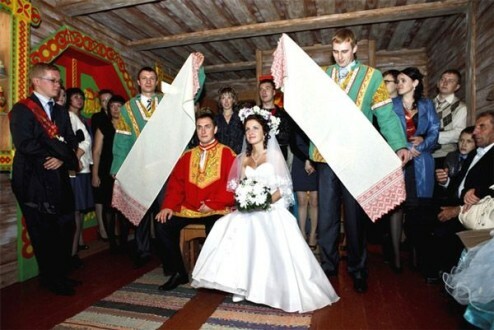
Excuses and hassles
Russian wedding was preceded by several preliminary rites.
- The first thing in the house of the bride was a matchmaker. With her were discussed the conditions on which the girl was given, the size of the dowry. During the conversation, the matchmaker never sat down, because it was believed that after this the case may not be made famous. In addition, she did not touch the meal, so that the children of the future bride would not be drunkards and gluttons.
- Excuses( in other words, "drinking") occur after visiting a matchmaker. The groom or his parents sent the matchmakers to the house. Here they were seated at a table and treated. If the negotiations were successful, everyone congratulated each other, while kissing. The nest did not take part in the feast. She had to sit in the next room and cry, loudly lamenting. After the conspiracy, the maiden girl should not go out for a walk and work. She was sitting at home and sewing a dowry together with her friends. Only close people could see the bride's face now. In the presence of the others she covered herself with a handkerchief.
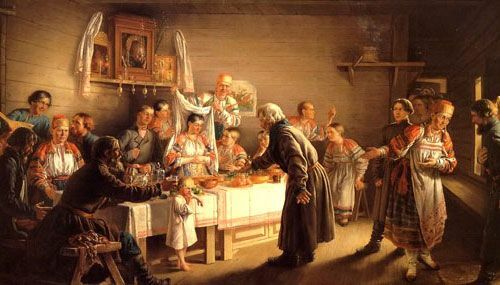
- A few days before the wedding, the bridegroom's parents visited the house of the future daughter-in-law. This visit was called the handbook. During the feast, the door in the house was bolted and people were not allowed in, so that they could not jinx the matter. After the ritual, the groom had the right to visit the bride. He brought her gifts and took part in a get-together with her friends.
Preparing the bride and groom for the wedding
Russian wedding is always visible and audible from afar. This is perhaps the most fun and colorful holiday of all that happens in a person's life. This is understandable, because there is nothing more important than the family that is born on this day. It was on the day of marriage in Russia that they were especially attentive to the observance of all wedding ceremonies. The first of these was the gathering to the altar of the bride and groom.
Preparing the bride
The female wedding attire was made in red tones. It consisted of several main parts, the main one of which was the sarafan. For him, the best fabric was chosen. It was decorated with embroidery, beads, gold and silver braid. For brides from well-to-do families, the sarafan was sewn from brocade and trimmed with pearls and valuable fur. The total weight of the wedding dress could reach 15 kg. The wedding dress, as a rule, was placed in a chest and betrayed from generation to generation. Under the sarafan, several lower skirts and a wedding shirt were worn. 
The head of the bride was first decorated with a wreath woven from wildflowers. Then it was replaced by a decorated ribbon or hoop that was tied around the head. In this case, the hair remained loose or plaited into one braid. Over the headdress was worn a veil or veil, which had a dual purpose. On the one hand, it was an ornament, and on the other hand, it protected the bride from spoiling and evil spirits.
I must say that the bride was wearing a beautiful suit not at once. In the beginning she dressed in clothes of dark, and sometimes black. It symbolized the sorrow of a girl who left her home to strangers. Only after the wedding the bride put on festive clothes. 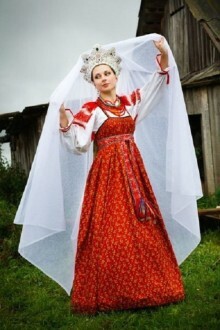
The wedding dress was stuck with needles without needles and pins without heads, and the body of the girl was wrapped with scraps of cross-stitch with countless nodules, so that she would not be jinxed during the ceremony. In the bride's shoes, money and grain were poured. It was believed that this would help make her family prosperous.
Dressed bride covered with a handkerchief, saving this way from the evil eye. Then she was seated at the table on a bench lined with a fur coat. According to the belief, if you sit on the fur, then the family will live in wealth, and bad people can not hurt.
Around the young girlfriends sat down. They were later joined by relatives. The table was covered with a white tablecloth and pies were put on it. Everyone was expecting a new family.
Preparation of the groom
The guy also prepared for the wedding from the early morning. His friends and relatives gathered to decorate the wagons with ribbons, flowers and bells.
The man's outfit consisted of pants and a red or white shirt, belted with a long sash. The collar and sleeves of the shirt were embroidered with traditional symbols, which denoted happiness and prosperity. In the gate and hem, as well as the bride, needles and pins were stuck. To protect from the evil eye in his pocket, the young man often put a knife. 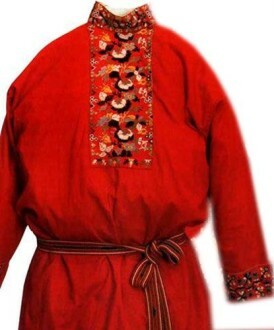
Arrival of the wedding cortege and rite of "ransom"
By the appointed time, a bridal train appeared at the bride's house. It included the groom himself, his friends and relatives, matchmakers. The first was the friend who held the icon in front of him. At the wedding, he guarded the groom and conducted humorous negotiations, "redeeming" a place for a young man at a festive table. According to the Russian tradition, this wedding ceremony was noisy and fun. Look at it was usually going to all the neighbors.
1. The father of the bride came out to meet the "train".He invited guests to the house, but not immediately.
- At the beginning the neighbors were blocking the way to the groom. The druzhka was obliged to give them wine, beer, pies and gingerbread to free the way for the young.
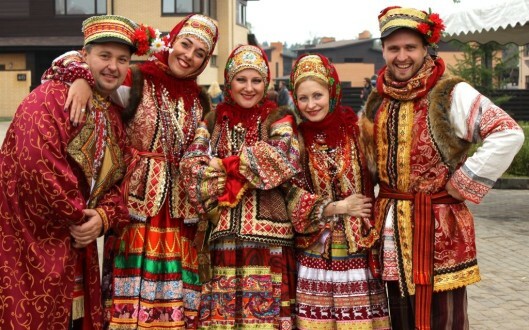
- When the wedding cortege approaches the gate or door, it too was locked. The friend knocked, three times pronounced the name of the Lord, and then said these words: "Who would open the gate and open the door for us, and let us, good fellows, to the owners?"
- After that, the head of the family opened the door before the guests and invited them to enter.
2. As soon as the groom and his entourage came in, the bride, according to custom, began to cry and wail with renewed vigor. By this she showed her affection for her father's house and family, which she must leave for good. The others were joking and having fun. No one reacted to her crying. The ceremony of "redemption" of the place at the table began - one of the most cheerful customs of the Russian wedding. The ceremony was held in several stages. 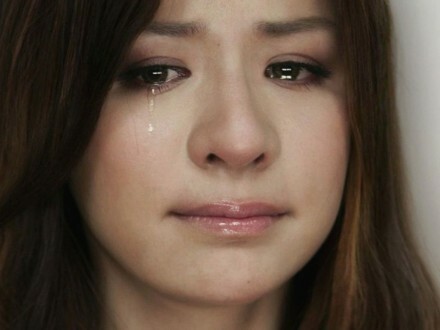
- Before the guests lined up bridesmaids and sang, referring to a friend:
"Our good friend is on our way,
I'm sick like this!
The friend is good!
Friend of greetings!
Come on, buddy, ride,
Give us kalachi! »
The friend thanked them for the song and gave them alcohol and pies. 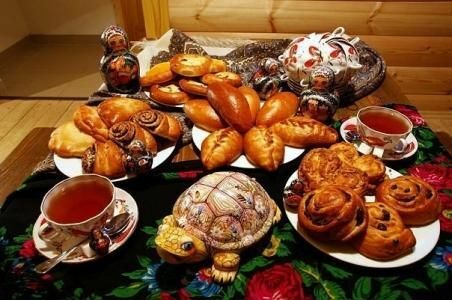
- Having stamped his foot, the cousin turned to the bride's parents, asked questions about health and well-being, and also gave bows from the groom's parents.
- After a bow to the bride's parents, the boyfriend turned to the men, making a "slander" on them. With similar comic "slander" he addressed to other present: unmarried girls, young women, old people and children.
- Guests answered a friend with playful verses or songs of approximate such content:
"Oh, have a friend -
The nose crocheted!
Oh, at friends -
Head with an egg! »
The friend gave them money so that they stopped" slandering "him. 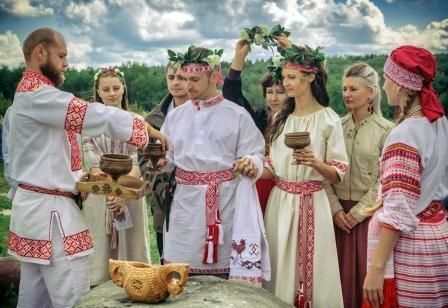
3. When the mutual exchange of courtesies ended, the mate proceeded to the main part - "ransom" for the groom of the place next to the bride. During this action, a kind of spectacle was played out, all scenes of which unfolded in strict accordance with the traditions of the Russian wedding ceremony.
- The friend asked the owners: "Where would I put the son-in-law with my guests planted?".They pointed out to him a close relative of a young man who "sells" places.
- The friend turned to the "merchant" with a proposal to give his place to the groom and sit at the guests table. But he refused to get up for nothing. Then my friend started "bargaining".At that moment, a dish was set up for the "redemption" on the table. The friend and the "dealer in places" conducted a dialogue of approximately this content:
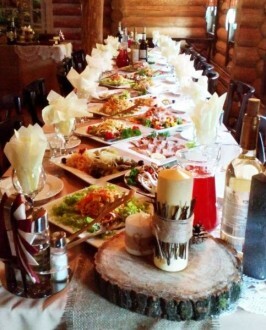
- How much do you want and what will you take: treasury or something else? Our prince's name is full.
- If I ask, then give it. Put seven rubles for me to start, so that everyone would be pleased.
- To collect( with these words the friend laid out money on the substituted dish).
- Give now that is brighter than the sun, more beautiful than the stars of heaven.
- Please accept.
Speaking these words, the friend gave the image with which he walked in front of the wedding train. The "seller" put him in the box, located in the right( red) corner of the room.
- Give me three fields: spring, rye, yes couples.
- Take it.
Answering, the cousin gives the brother of the bride a loaf, pie and fried patties from potatoes.
- Serve me a foamy sea on five pillars.
- Here, take it.
The druzhka is serving beer in an oak jug. 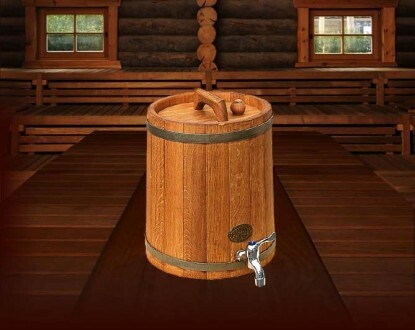
- After that, the seller and the friend started to think out each other various complex riddles. When all questions were asked and the answers were given, the "salesman" said: "Give me, my friend, something our master does not have in the house."
4. After that, the other members of the wedding train buy seats from the girls and sit at the table in the following order:
- to the honorable place, under the image, the closest relative of the groom sits down;
- next to the uncle;
- opposite the bride and groom seated friend with fellow;
- the rest of the guests are located "according to order".
When all present sit down, each of them is drawn by a bride. She asks for a glass of wine. The guest should listen to the treatment standing up, put money on the dish and drink. 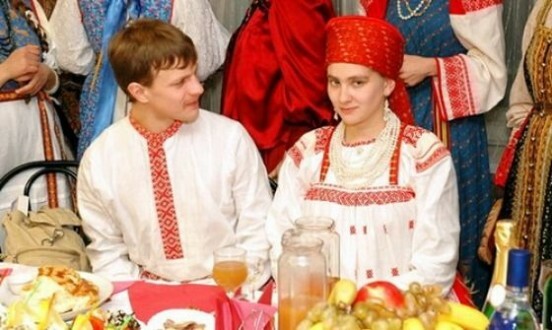
At the end, the bride with the same proposal turns to her future husband. He does not get up and does not take the proposed glass. The request of the daughter is repeated also by the owner of the house, but after that the newlyweds must refuse. Then the bride gets up and, bowing, gives him a glass of beer. The groom stands up and takes the glass from her hands. Then both sit down.
5. When all the guests have a drink and a snack, the friend gets up and invites the bride's parents to bless their future spouses. After him, thanks to the hosts, stand up and the rest of the guests.
- The friend brings the young from the table. The parents of the bride and the gods bless them with icons and crosses in their hands. The bride of all kisses and says goodbye. When saying goodbye at a Russian wedding, a girl should cry in a voice.
- All went to the temple, sitting in the carriage in the following order: a friend with a friend;groom with his own brother;bride's girlfriends and matchmaker;other relatives by seniority.
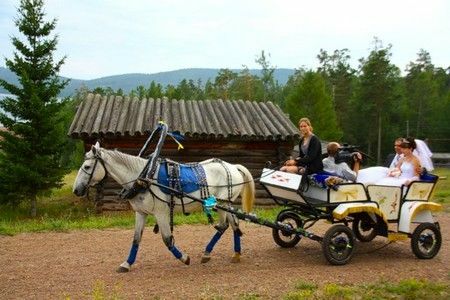
Wedding
The first ceremony was performed at the porch. The young took hold of the iron brace and asked that she take back their troubles and illnesses. It was believed that iron, especially rusty, is capable of absorbing a person's ailments.
Accompanied by the clergyman, the brothers with the lit candles passed into the center of the temple. They stood in front of the desk in front of a light shawl spread out on the floor. According to the letter, the one who will step on him first, and will be the main one in the family.
Then the holy father asked whether the groom and the bride voluntarily marry. Receiving an affirmative answer, he proceeded to the wedding ceremony. It consisted of several successive actions:
- walking around the analog.
- drinking wine;
- laying crowns;
- betrothal;
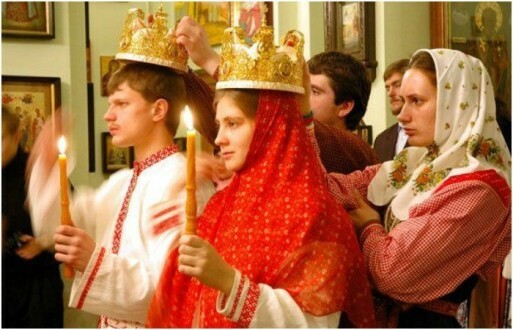
Let's look at each step in more detail.
1. When engaged, the priest took a ring of gold and put it on his fiancé.Then a ring of silver was put on the bride. The golden ring symbolizes the daylight. His light in marriage is likened to the head of the family. Silver is like the light of the moon, which shines, reflecting the light of the sun.
The newlyweds exchanged rings three times with the help of a friend or clergyman. As a result, the silver ring remained with the husband, and the gold ring with the wife.
2. Then the priest took a crown and three times crossed the groom, letting him apply to the face of Christ, attached to the crown. During this action, the wedding words were pronounced. 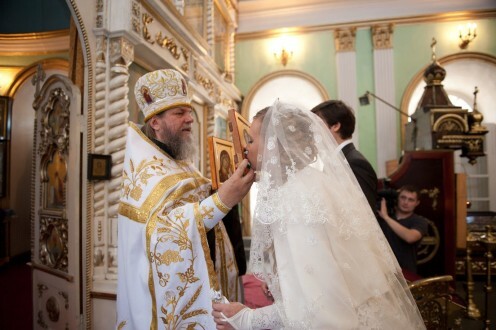
In the same way, the priest blessed the young man by giving her the kiss of the face of the Virgin. After that, the servant of the church crowned the newlyweds' heads. The crowns symbolize the supremacy of both in the family alliance.
When the priest pronounced the wedding words, the newlywed, to whom they addressed, had to cross himself and say quietly: "I, the servant of God( name), are getting married, and my illnesses are not crowned."According to the belief, if the spouse has ailments, then after the ceremony they will not be cured.
3. Then the newlyweds at three receptions drank wine from the bowl that they presented, which symbolized their unity. The groom was the first to bring the vessel to his lips. 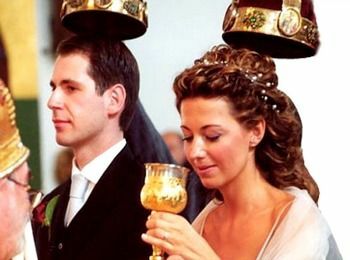
4. After this, the priest joined the hands of the couple, covered with a pair of epitrachel and three times circled around the analogue. This action symbolized the eternity of the conjugal union.
At the end of the ceremony, the priest removed the crowns from the newlyweds and led them to the Royal Gates. There the man kissed the icon of the Savior, and the woman - the Virgin. Then they changed places.
The bride and groom kissed the crucifix, and the priest gave them icons that the young ones had brought to the church in advance. These faces the newly-made husband and wife were to be placed in their own house, in which they settled after the douche. 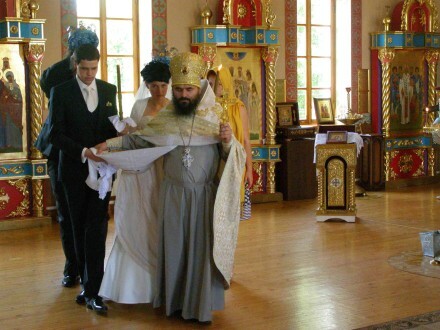
Wedding Feast
When the wedding ceremony was over, the young wife ceased to shed tears. From the church, the wedding cortege was sent to the house of her husband's parents. They met the young with icons and bread and salt. Father held the face in his hands, and his mother - a loaf. Guests showered a couple of grain, coins and hops. The godparents blessed the newlyweds with crosses.
After this, the couple were taken to a special room and quickly fed. The bride took off her "mourning" clothes and put on a bright wedding dress. The girlfriends braided her with two braids and wrapped them around her head. Over the women's hair was worn headgear( usually kokoshnik) and veil. 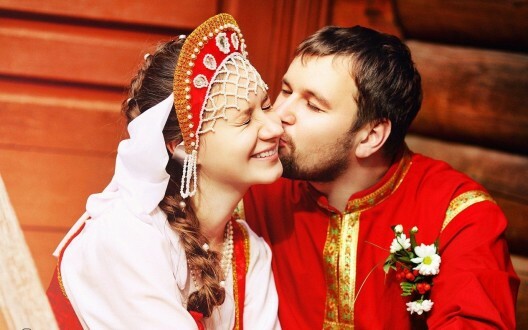
And, finally, everyone was going to a traditional feast for Russian wedding. Here, as in other moments of the marriage, many different traditions and rituals were observed. We list the most important of them.
- The newly-wedged spouses were again placed on a fur-lined fur coat. They had to tightly twist their arms and legs so that the "black cat" ran between them, and they did not quarrel.
- At the table guests drank and ate their fill. Unlike the rest, the newlyweds did not touch the dishes and drinks. Before them was a plate with crossed spoons and a slice of bread sprinkled with salt.
- Of the dishes on the festive table were required a variety of pies. They were served in large quantities and ate instead of bread. A feast with chicken noodles or cabbage soup started. Everything depended on the material condition of the parents of the spouses. After that, a roast pork or kidney was put on the table, or a goose stuffed with apples was served.

- In the houses of the bride and groom baked the kurikas, which symbolized fertility. The cake from the house of the spouse was decorated with human figures symbolizing family relations. Kurnik from the bride's relatives - flowers that were associated with her beauty. The kurniki were placed in the center and cut at the end of the feast by a friend. He served pies for guests, for which they thanked the young people with money.
- At the wedding, each participant in the feast was given some gift. Men were presented with embroidered belts, women - scarves and ribbons, children were presented with sweets from the "groom's box".The bride presented the groom with an embroidered shirt. He, in turn, gave her jewelry. Guests presented young people with different utensils needed for household use, and money.
- After the feast, the guests were beaten to pieces for happiness. Then the newly-made spouses were assigned to spend the night in a cold hut, on the threshold of which they broke up bowls, plates and pots.

"Princely table" and the third day of the Russian wedding
The second day of the Russian folk wedding was held entirely in the groom's house and was called "the prince's table".
In the morning the guests went to wake up the young. All remained at the threshold to beat the dishes, and the matchmaker went directly to the bedchamber. When the newlyweds appeared, the participants continued to beat the plates and cups, congratulating the newlyweds.
Wash and dressed newlyweds were sitting at the table. Behind them sat the rest of the guests, and breakfast began. After that, the young people went to the homeland's unnamed, to convene her for a "princely table".His wife's parents exhibited a treat. Then the newlyweds left, and after them the invited guests gathered in the house of the young spouse. 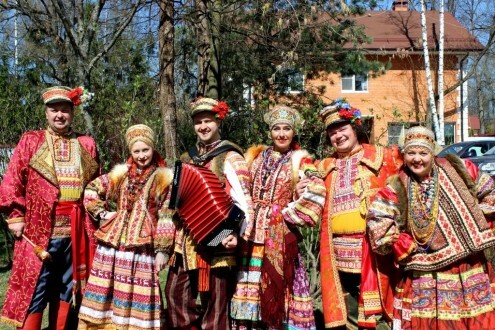
On the second day, the honorary place at the table was occupied by the bride's relatives. The groom's parents did not sit down at the table. They walked around, treating the feasting. The rest of the groom's relatives offered food and drinks. As on the first day, young people had to sit tight against one another, and not touch food. They only had the right to sip the beer or wine they had brought.
Behind the prince's table, the most popular was the rite of kissing. Guests often shouted to their young spouses: "It's bitter!", And then they asked: "Can not you sweeten it?".Young rose, bowed, kissed and said: "Try it, now it's sweet!".Screaming drank from his glass and reported: "Now it's very sweet."Then the guest approached the couple and kissed them. 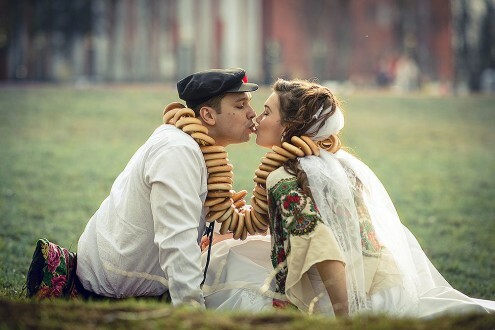
Invited couples treated these words to each other. And when served hot, each guest approached the newlyweds with a slice of roast and kissed with them, and then returned to his second half or svye, repeating the procedure.
After the feast, the guests continued to walk until midnight. Most of them went home, but some stayed at home.
On the third day of
, the young wife was baking pancakes, which she treated to her husband's relatives. In the evening young girls and guys came to the house. They arranged games and dances. If the bride came from a distance, then on the holiday she made new acquaintances, presenting guests with different sweets and pies. 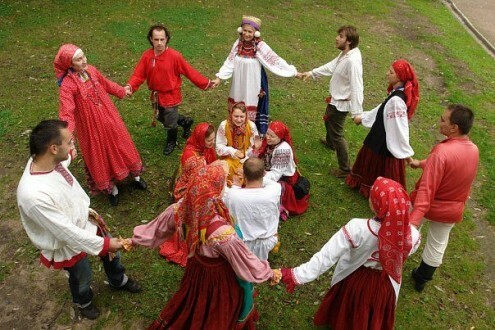
As you can see, the Russian wedding was held with observance of many rituals. If during the wedding try to observe at least the most important of them, you can get a fun holiday, which will be remembered not only by its immediate participants, but also by those around them.
Video on topic:
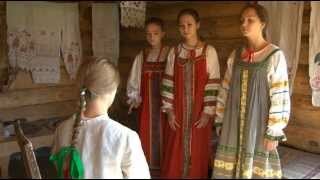 19:50
19:50  8:59
8:59 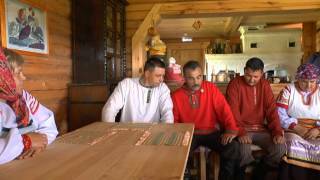 18:01
18:01 